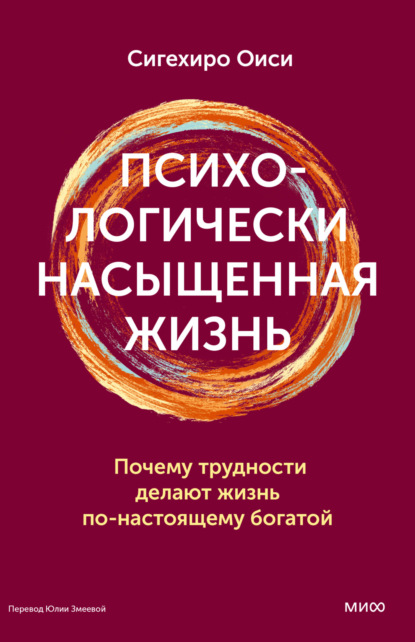Психологически насыщенная жизнь. Почему трудности делают жизнь по-настоящему богатой

- -
- 100%
- +
19
Karoline Hofslett Kopperud and Joar Vittersø, “Distinctions Between Hedonic and Eudaimonic Well-Being: Results from a Day Reconstruction Study Among Norwegian Jobholders,” Journal of Positive Psychology 3, no. 3 (2008): 174–81.
20
Barbara Fredrickson, Karen Grewen, Kimberly Coffey, Sara Algoe, Ann Firestine, Jesusa Arevalo, Jeffrey Ma, and Steven Cole, “A Functional Genomic Perspective on Human Well-Being,” Proceedings of the National Academy of Sciences 110, no. 33 (2013): 13684–89; see also Nicholas Brown, Douglas MacDonald, Manoj Pratim Samanta, Harris Friedman, and James Coyne, “A Critical Reanalysis of the Relationship Between Genomics and Well-Being,” Proceedings of the National Academy of Sciences 111, no. 35 (2014): 12705–09.
21
David Disabato, Fallon Goodman, Todd Kashdan, Jerome Short, and Aaron Jarden, “Different Types of Well-Being? A Cross-Cultural Examination of Hedonic and Eudaimonic Well-Being,” Psychological Assessment 28, no. 5 (2016): 471–82, https://doi.org/10.1037/pas0000209; B. M. L. Baselmans and Meike Bartels, “A Genetic Perspective on the Relationship Between Eudaimonic and Hedonic Well-Being,” Scientific Reports 8 (2018): 14610.
22
Todd Kashdan, Robert Biswas-Diener, and Laura King, “Reconsidering Happiness: The Costs of Distinguishing Between Hedonics and Eudaimonia,” Journal of Positive Psychology 3, no. 4 (2008): 219–33; Ed Diener, Derrick Wirtz, William Tov, Chu Kim-Prieto, Dong-won Choi, Shigehiro Oishi, and Robert Biswas-Diener, “New Well-Being Measures: Short Scales to Assess Flourishing and Positive and Negative Feelings,” Social Indicators Research 97 (2010): 143–56; Martin Seligman, Flourish: A Visionary New Understanding of Happiness and Well-Being (New York: Free Press, 2011).
23
Carol Dweck, Mindset: The New Psychology of Success (New York: Random House, 2006).
24
Ed Diener, Ed Sandvik, and William Pavot, “Happiness Is the Frequency, Not the Intensity, of Positive Versus Negative Affect,” in Subjective Well-Being: An Interdisciplinary Perspective, eds. Fritz Strack, Michael Argyle, and Norbert Schwarz (Oxford: Pergamon Press, 1991), 119–39.
25
Уильям Джеймс (1842–1910) – американский психолог, один из основателей философского прагматизма и функционализма. Здесь и далее, если не указано иное, прим. ред.
26
William James, The Varieties of Religious Experience: A Study in Human Nature (New York: Longmans, Green, 1902), 136.
27
Mohsen Joshanloo, Dan Weijers, Ding-Yu Jiang, Gyuseog Han, et al., “Fragility of Happiness Beliefs Across 15 National Groups,” Journal of Happiness Studies 16 (2015): 1185–210.
28
Толстой цитируется в: James, Varieties of Religious Experience, 154.
29
Ronnie Janoff-Bulman, Shattered Assumptions: Towards a New Psychology of Trauma (New York: Free Press, 1992).
30
Julie Scelfo, “Suicide on Campus and the Pressure of Perfection,” New York Times, July 27, 2015.
31
Aristotle, Ethics, trans. J. A. K. Thomson (New York: Penguin Classics, 1976).
32
William James, The Varieties of Religious Experience: A Study in Human Nature (New York: Longmans, Green, 1902), 78.
33
Ed Diener, “Subjective Well-Being: The Science of Happiness and a Proposal for a National Index,” American Psychologist 55, no. 1 (2000): 34–43, https://doi.org/10.1037/0003-066X.55.1.34.
34
Sonja Lyubomirsky, Laura King, and Ed Diener, “The Benefits of Frequent Positive Affect: Does Happiness Lead to Success?” Psychological Bulletin 131, no. 6 (2005): 803–55, https://doi.org/10.1037/0033-2909.131.6.803; Julia Boehm and Sonja Lyubomirsky, “Does Happiness Promote Career Success?” Journal of Career Assessment 16, no. 1 (2008): 101–16.
35
Scelfo, “Suicide on Campus.”
36
“Suicide Data and Statistics,” Centers for Disease Control and Prevention; 2020 National Survey on Drug Use and Health (NSDUH), Substance Abuse and Mental Health Services Administration (SAMHSA).
37
Luo Lu and Robin Gilmour, “Culture and Conceptions of Happiness: Individual Oriented and Social Oriented SWB,” Journal of Happiness Studies 5, no. 3 (2004): 269–91, https://doi.org/10.1007/s10902-004-8789-5.
38
Yukiko Uchida and Shinobu Kitayama, “Happiness and Unhappiness in East and West: Themes and Variations,” Emotion 9, no. 4 (2009): 441–56, https://doi.org/10.1037/a0015634.
39
Condé Nast Store (online), “New Yorker, January 17th, 1959.”
40
Richard Lucas, Andrew Clark, Yannis Georgellis, and Ed Diener, “Reexamining Adaptation and the Set Point Model of Happiness: Reactions to Changes in Marital Status,” Journal of Personality and Social Psychology 84, no. 3 (2003): 527–39, https://doi.org/10.1037/0022-3514.84.3.527; Maike Luhmann, Wilhelm Hofmann, Michael Eid, and Richard Lucas, “Subjective Well-Being and Adaptation to Life Events: A Meta-Analysis,” Journal of Personality and Social Psychology 102, no. 3 (2012): 592–615, https://doi.org/10.1037/a0025948.
41
Eunkook Suh, Ed Diener, and Frank Fujita, “Events and Subjective Well-Being: Only Recent Events Matter,” Journal of Personality and Social Psychology 70, no. 5 (1996): 1091–102, https://doi.org/10.1037/0022-3514.70.5.1091.
42
Timothy Wilson and Daniel Gilbert, “Explaining Away: A Model of Affective Adaptation,” Perspectives on Psychological Science 3, no. 5 (2008): 370–86; Kennon Sheldon, Alexander Gunz, Charles Nichols, and Yuna Ferguson, “Extrinsic Value Orientation and Affective Forecasting: Overestimating the Rewards, Underestimating the Costs,” Journal of Personality 78, no. 1 (2010): 149–78.
43
Daniel Gilbert, Elizabeth Pinel, Timothy Wilson, Stephen Blumberg, and Thalia Wheatley, “Immune Neglect: A Source of Durability Bias in Affective Forecasting,” Journal of Personality and Social Psychology 75, no. 3 (1998): 617–38.
44
Ed Diener, Ed Sandvik, and William Pavot, “Happiness Is the Frequency, Not the Intensity, of Positive Versus Negative Affect,” in Subjective Well-Being: An Interdisciplinary Perspective, eds. Fritz Strack, Michael Argyle, and Norbert Schwarz (Oxford: Pergamon Press, 1991), 119–39.
45
Ed Diener and Martin Seligman, “Very Happy People,” Psychological Science 13, no. 1 (2002): 81–84; Robert Emmons and Ed Diener, “Factors Predicting Satisfaction Judgments: A Comparative Examination,” Social Indicators Research 16, no. 2 (1985): 157–67.
46
Jonathan Haidt, The Happiness Hypothesis: Finding Modern Truth in Ancient Wisdom (New York: Basic Books, 2006).
47
Alex Fletcher, “Ten Things You Never Knew About Quentin Tarantino,” Digital Spy, August 12, 2009.
48
Fritz Strack, Leonard Martin, and Sabine Stepper, “Inhibiting and Facilitating Conditions of the Human Smile: A Nonobtrusive Test of the Facial Feedback Hypothesis,” Journal of Personality and Social Psychology 54, no. 5 (1988): 768–77, https://doi.org/10.1037/0022-3514.54.5.768.
49
Maarten Derksen and Jill Morawski, “Kinds of Replication: Examining the Meanings of ‘Conceptual Replication’ and ‘Direction Replication,’ ” Perspectives on Psychological Science 17, no. 5 (2022): 1490–505; Nicholas Coles, David March, Fernando Marmolejo-Ramos, Jeff Larsen, et al., “A Multi-Lab Test of the Facial Feedback Hypothesis by the Many Smiles Collaboration,” Nature Human Behaviour 6 (2022): 1731–42.
50
Tom Noah, Yaacov Schul, and Ruth Mayo, “When Both the Original Study and Its Failed Replication Are Correct: Feeling Observed Eliminates the Facial-Feedback Effect,” Journal of Personality and Social Psychology 114, no. 5 (2018): 657–64, https://doi.org/10.1037/pspa0000121; Abigail Marsh, Shawn Rhoads, and Rebecca Ryan, “A Multi-Semester Classroom Demonstration Yields Evidence in Support of the Facial Feedback Effect,” Emotion 19, no. 8 (2019): 1500–1504.
51
William Fleeson, Adriane Malanos, and Noelle Achille, “An Intraindividual Process Approach to the Relationship Between Extraversion and Positive Affect: Is Acting Extraverted as ‘Good’ as Being Extraverted?” Journal of Personality and Social Psychology 83, no. 6 (2002): 1409–22, https://doi.org/10.1037/0022-3514.83.6.1409; J. Murray McNiel and William Fleeson, “The Causal Effects of Extraversion on Positive Affect and Neuroticism on Negative Affect: Manipulating State Extraversion and State Neuroticism in an Experimental Approach,” Journal of Research in Personality 40, no. 5 (2006): 529–50; Mariya Davydenko, John Zelenski, Ana Gonzalez, and Deanna Whelan, “Does Acting Extraverted Evoke Positive Social Feedback?” Personality and Individual Differences 159 (2020): 109883.
52
Nicholas Epley and Juliana Schroeder, “Mistakenly Seeking Solitude,” Journal of Experimental Psychology: General 143, no. 5 (2014): 1980–99.
53
Juliana Schroeder, Donald Lyons, and Nicholas Epley, “Hello, Stranger? Pleasant Conversations Are Preceded by Concerns About Starting One,” Journal of Experimental Psychology: General 151, no. 5 (2022): 1141–53, https://doi.org/10.1037/xge0001118.
54
Iris Mauss, Maya Tamir, Craig Anderson, and Nicole Savino, “Can Seeking Happiness Make People Unhappy? Paradoxical Effects of Valuing Happiness,” Emotion 11, no. 4 (2011): 807–15, https://doi.org/10.1037/a0022010; Emily Willroth, Gerald Young, Maya Tamir, and Iris Mauss, “Judging Emotions as Good or Bad: Individual Differences and Associations with Psychological Health,” Emotion 23, no. 7 (2023): 1876–90, https://doi.org/10.1037/emo0001220.
55
Lucy McGuirk, Peter Kuppens, Rosemary Kingston, and Brock Bastian, “Does a Culture of Happiness Increase Rumination Over Failure?” Emotion 18, no. 5 (2018): 755–64, https://doi.org/10.1037/emo0000322.
56
Egon Dejonckheere, Joshua Phee, Peter Baguma, Oumar Barry, et al., “Perceiving Societal Pressure to Be Happy Is Linked to Poor Well-Being, Especially in Happy Nations,” Scientific Reports 12, no. 1 (2022): 1514.
57
Shigehiro Oishi, Jesse Graham, Selin Kesebir, and Iolanda Costa Galinha, “Concepts of Happiness Across Time and Cultures,” Personality and Social Psychology Bulletin 39, no. 5 (2013): 559–77.
58
James Gross, “Emotion Regulation in Adulthood: Timing Is Everything,” Current Directions in Psychological Science 10, no. 6 (2001): 214–19, https://doi.org/10.1111/1467-8721.00152.
59
Ethan Kross and Ozlem Ayduk, “Making Meaning out of Negative Experiences by Self-Distancing,” Current Directions in Psychological Science 20, no. 3 (2011): 187–91, https://doi.org/10.1177/0963721411408883; Ethan Kross and Ozlem Ayduk, “Self-Distancing: Theory, Research, and Current Directions,” Advances in Experimental Social Psychology 55 (2017): 81–136.
60
Emma Bruehlman-Senecal, Ozlem Ayduk, and Oliver John, “Taking the Long View: Implications of Individual Differences in Temporal Distancing for Affect, Stress Reactivity, and Well-Being,” Journal of Personality and Social Psychology 111, no. 4 (2016): 610–35, https://doi.org/10.1037/pspp0000103; Dylan Benkley, Emily Willroth, Ozlem Ayduk, Oliver John, and Iris Mauss, “Short-Term Implications of Long-Term Thinking: Temporal Distancing and Emotional Responses to Daily Stressors,” Emotion 23, no. 2 (2023): 595–99, https://doi.org/10.1037/emo0001140.
61
Daniel Gilbert, Elizabeth Pinel, Timothy Wilson, Stephen Blumberg, and Thalia Wheatley, “Immune Neglect: A Source of Durability Bias in Affective Forecasting,” Journal of Personality and Social Psychology 75, no. 3 (1998): 617–38.
62
Barry Schwartz, Andrew Ward, John Monterosso, Sonja Lyubomirsky, Katherine White, and Darrin Lehman, “Maximizing Versus Satisficing: Happiness Is a Matter of Choice,” Journal of Personality and Social Psychology 83, no. 5 (2002): 1178–97, https://doi.org/10.1037/0022-3514.83.5.1178.
63
Sheena Iyengar, Rachael Wells, and Barry Schwartz, “Doing Better but Feeling Worse. Looking for the ‘Best’ Job Undermines Satisfaction,” Psychological Science 17, no. 2 (2006): 143–50.
64
Sonja Lyubomirsky and Lee Ross, “Changes in Attractiveness of Elected, Rejected, and Precluded Alternatives: A Comparison of Happy and Unhappy Individuals,” Journal of Personality and Social Psychology 76, no. 6 (1999): 988–1007, https://doi.org/10.1037/0022-3514.76.6.988.
65
Michael Lewis, The New New Thing (New York: W. W. Norton, 2000), 259.
66
Sonja Lyubomirsky and Lee Ross, “Hedonic Consequences of Social Comparison: A Contrast of Happy and Unhappy People,” Journal of Personality and Social Psychology 73, no. 6 (1997): 1141–57.
67
Joar Vittersø and Yngvil Søholt, “Life Satisfaction Goes with Pleasure and Personal Growth Goes with Interest: Further Arguments for Separating Hedonic and Eudaimonic Well-Being,” Journal of Positive Psychology 6, no. 4 (2011): 326–35, https://doi.org/10.1080/17439760.2011.584548; Tenelle Porter, Diego Catalán Molina, Lisa Blackwell, Sylvia Roberts, Abigail Quirk, Angela Lee Duckworth, and Kali Trzesniewski, “Measuring Mastery Behaviours at Scale: The Persistence, Effort, Resilience, and Challenge-Seeking (PERC) Task,” Journal of Learning Analytics 7, no. 1 (2020): 5–18.
68
Huxley, Brave New World, 156.
69
Перевод Ю. М. Антоновского.
70
Friedrich Nietzsche, Thus Spoke Zarathustra: A Book for All and None, trans. Walter Kaufmann (1883–1892, translated 1954; reprint, New York: Penguin, 1978), 169–70.










